Which is better? LPVO scopes or red dot sights?
Though both can be compared for the few features they share, they’re inherently different in design and performance.
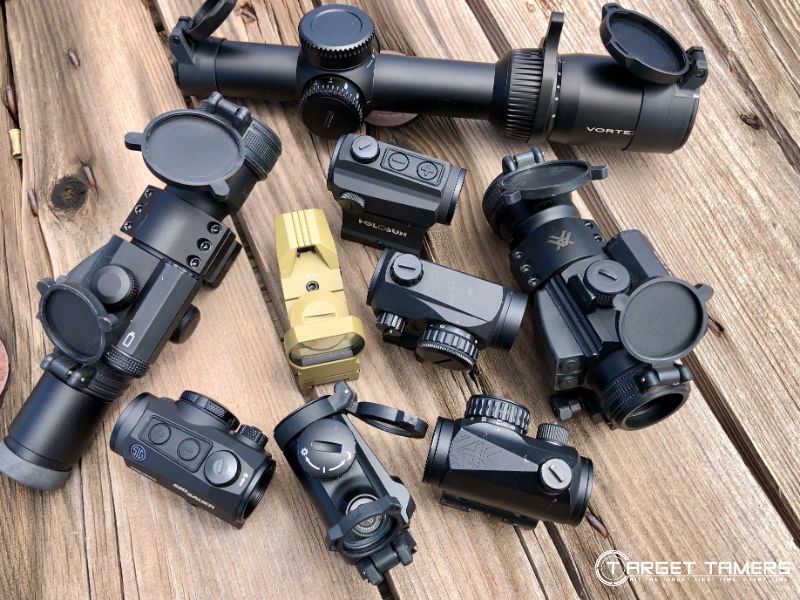
The LPVO (Low Power Variable Optic) typically starts at 1x magnification and reaches a maximum power range of 4x, 5x, 6x, 8x, or 10x. A red dot sight has 1x power though there are magnified options. The best optic is the one with the features best suited to the mission.
The real solution to this conundrum is to have both! But if neither the budget nor the need is there, this comparison guide will help to narrow down which is best for you.
Red Dot VS LPVO
There are inherent features of a red dot sight and LPVO that makes one better over the other depending on the needs of the application. Though the determinations of each category are based on generalities, every mission, circumstance, and shooter’s personal preferences make for different needs.
Thus, while one optic may be better suited to a specific application than the other, a shooter’s bias, expertise, and compounded experiences may make them the exception to the rule.
1. Magnification/Power
The LPVO has the advantage in magnification. Red dot sights are generally non-magnified (1x) optics and allow for seamless vision with two eyes open and an unlimited FOV. Though excellent for close-range work inside 100 yards, the LPVO offers power for longer reach and magnified observation.
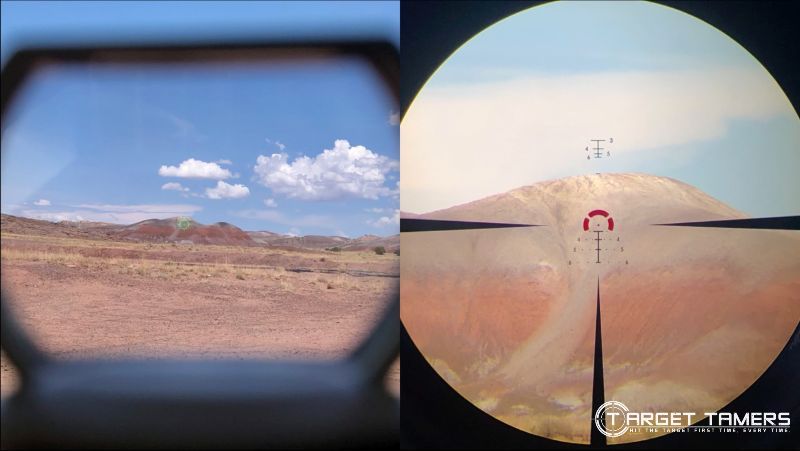
The drawback is acquiring true 1x performance with an LPVO. While this is an inherent benefit of red dot sights, users may see FOV edge distortion that resembles a fish-bowl effect. With proper use of the eyepiece lens (diopter), you can focus for a sharp FOV at 1x.
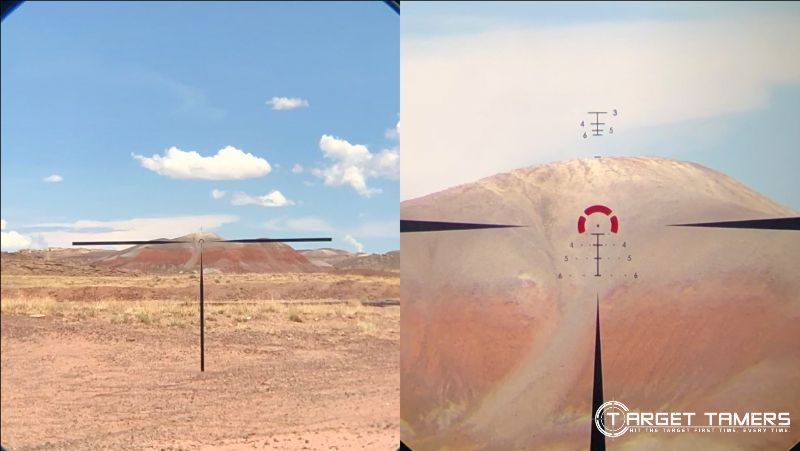
However, there could be slight focusing issues with the image at max power on 1-8x and 1-10x LPVOs after it has been focused for optimal, true 1x use. If the LPVO has a side focus or adjustable objective, it can remedy the parallax error (related to distance) that is more apparent at max power.
Even so, these small concerns can be addressed with correct use and know-how of a LPVO. When it comes to having power as an advantage, it’s better to have it and not need it than be without it when it’s needed.
Winner: LPVO
2. Close Range

Red dots are known for their superior close-range performance. This is based on the simple dot aiming point that comes in various MOA sizes, no magnification, unlimited FOV and eye relief, and the ability to use it easily with two eyes open.
Larger dots, like 6 MOA, are incredibly effective for close-range work, and even a small 2 MOA dot is suitable and easy enough to pick up. Though 2 MOA dots provide the ability to go further than 100 yards, red dots are generally reserved for short range work.
With low magnification, LPVOs can also provide red dot-like performance with red-dot like benefits. The real question of its ability to be just as effective at close range will be in the style of reticle. Some aiming points may be smaller than 1 MOA making it difficult to pick up at 1x or only a very small portion (usually the dot itself) is illuminated making visibility even harder.
Red dots certainly have the upper hand for close-quarter engagements.
Winner: Red Dot
3. Long Range
Overall, just as red dots are revered for tight, close-range work, the LPVO offers versatility for some long-range distance given its variable magnification and various reticles that includes BDC options.
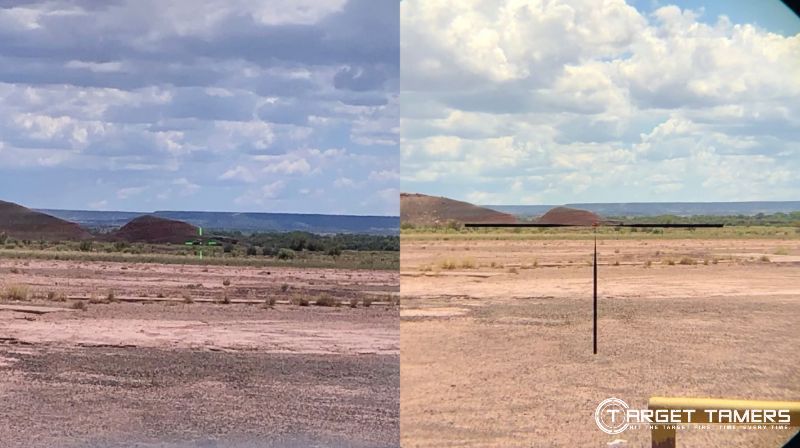
Red dots do not have magnification to adequately see further and dot subtension can become quite large the greater the distance making for precision accuracy somewhat difficult.
LPVO scopes in the 1-4x and 1-6x configuration are better suited to close to mid-range distances, say 0-300 yards. The 1-8x and 1-10x configurations would work rather well for distances out to 800 yards – not quite 1000.
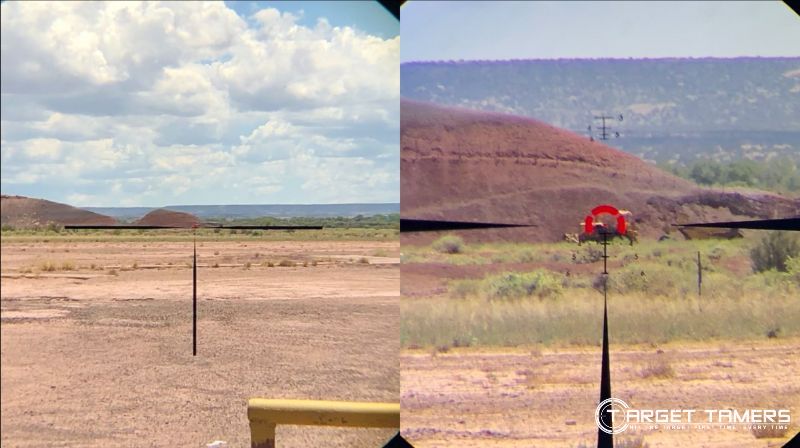
So, though neither would be a recommended option for long-range, when long-range means 1000+ yards, mid-range distances between 500-800 yards is within an LPVOs capability.
Winner: LPVO
4. Two Eyes Open
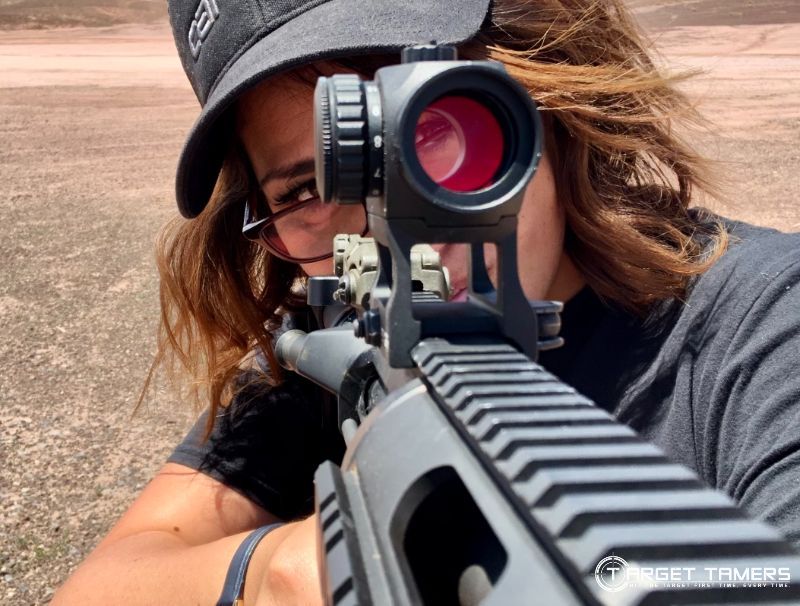
Can you use a LPVO with two eyes open? In general, you can use two eyes open with an LPVO on 1x power. In this case, 1x means the image is not magnified but it does not necessarily mean that this is how the brain interprets it.
Though similar to red dots when at 1x magnification, a LPVO has a lot more glass than a simple red dot. This equates to minor edge distortion that is noticeable through the LPVO. However, when you’re focused on a target downrange with the reticle, the FOV edge distortion all but disappears.
Due to the simplicity of red dot sight designs, they provide commendably clear FOVs and can be effortless to use with two eyes open. They’re designed to be used with two eyes open which results in an unlimited FOV, preservation of peripheral vision, and shared strain between both eyes.
When you have one eye closed, you’re putting more strain on the open eye which may be required when shooting for groups and when high accuracy is a demand. More focused concentration is the result with one eye closed and tends to be a practice better suited to LPVOs.
Winner: Red Dot
5. Focusing
Red dot sights do not have a focusing mechanism while LPVO scopes have an adjustable eyepiece (diopter) and perhaps a side focus to correct for parallax related to distance. These scope features help to improve FOV quality and reticle focus.
The most prevalent focusing issue with red dot sights is related to the dot. The dot may appear fuzzy and blurry, or it may appear to look like a starburst, smear, cluster of dots, or double dots. A fuzzy or blurry dot can usually be remedied by keeping your prescription glasses on or putting a magnifier behind it to adjust its sharpness and clarity via the diopter.
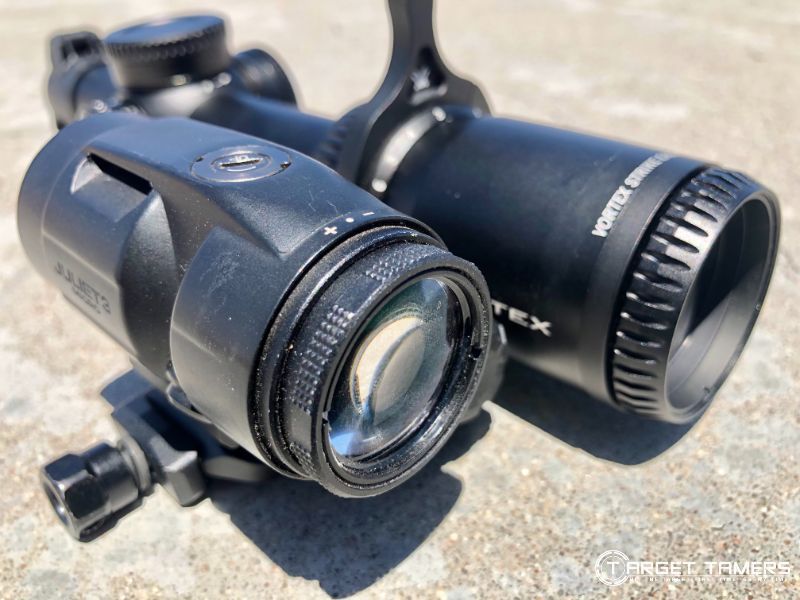
Some dot anomalies are usually not remedied without keeping your glasses on or using a prismatic red dot sight or scope (like a LPVO) that has a glass-etched reticle and diopter.
Though astigmatism is the usually the fast answer to why you see the dot differently, it can also be due to other refractive error conditions such as myopia (near-sightedness), hyperopia (far-sightedness), or presbyopia.
To acquire the best image and reticle focusing, a LPVO would be the recommendation and may be a great scope for old eyes. Though, a red dot sight with a green dot could be a fast fix for those bent on reflex sights.
Winner: LPVO
6. Reticles
In general, when it comes to reticle variations, the LPVO has an advantage over red dot sights. Most red dot sights feature a simple dot as the aiming point although few will offer multiple reticles with variations of crosshairs, circle and dot, etc.
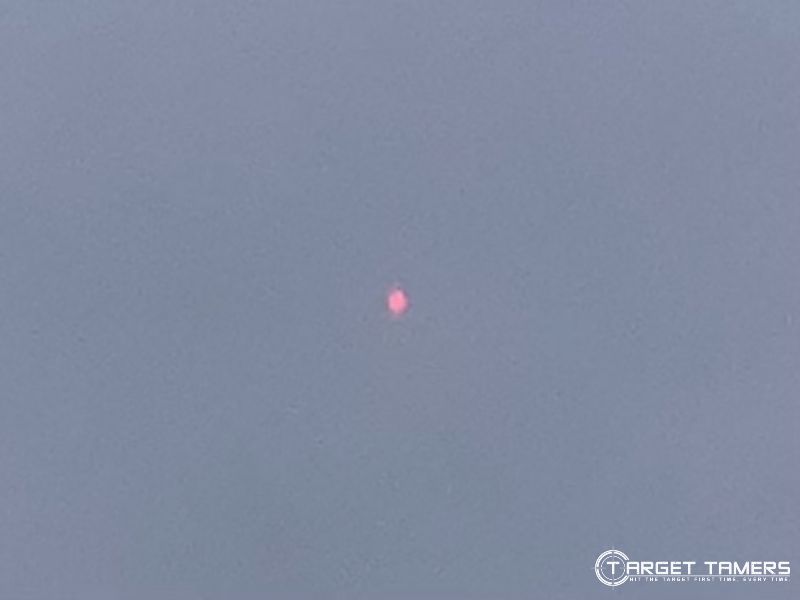
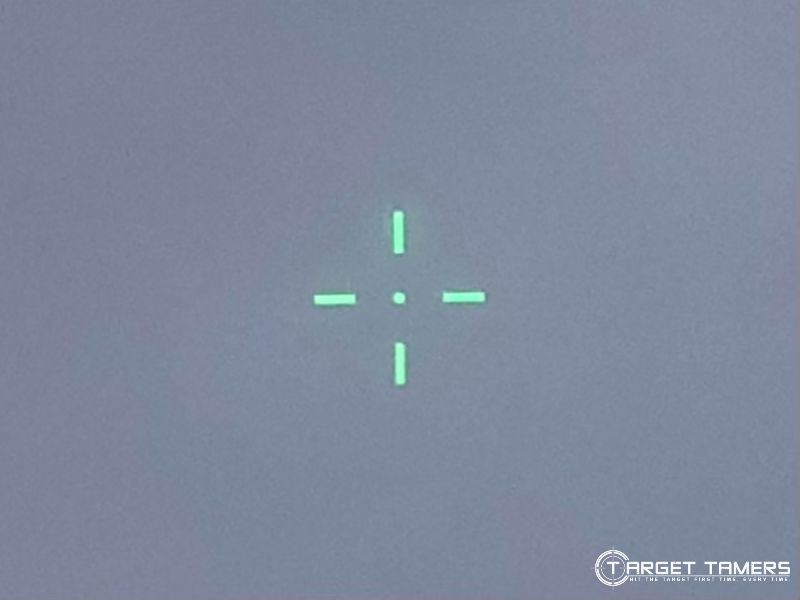
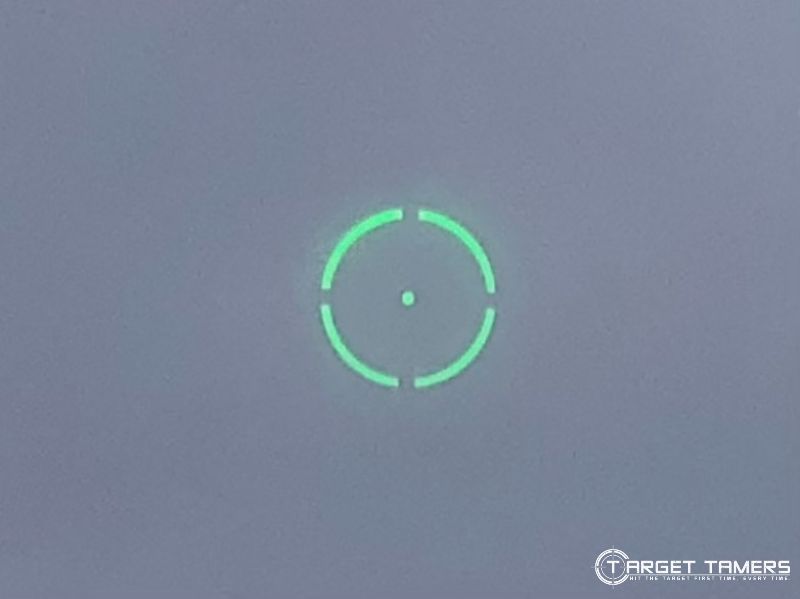
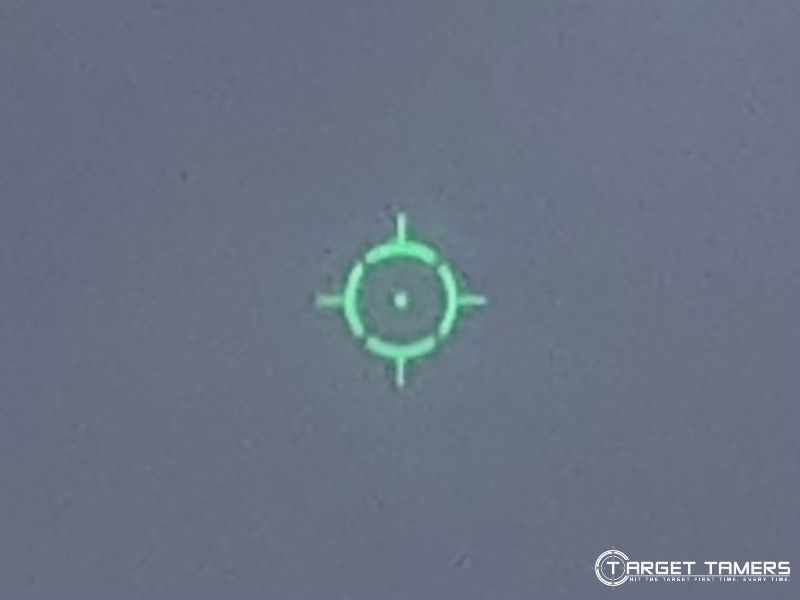
Given that LPVO scopes can go the distance, they offer various styles of reticles that allow for bullet drop compensation and maybe holdovers for wind.
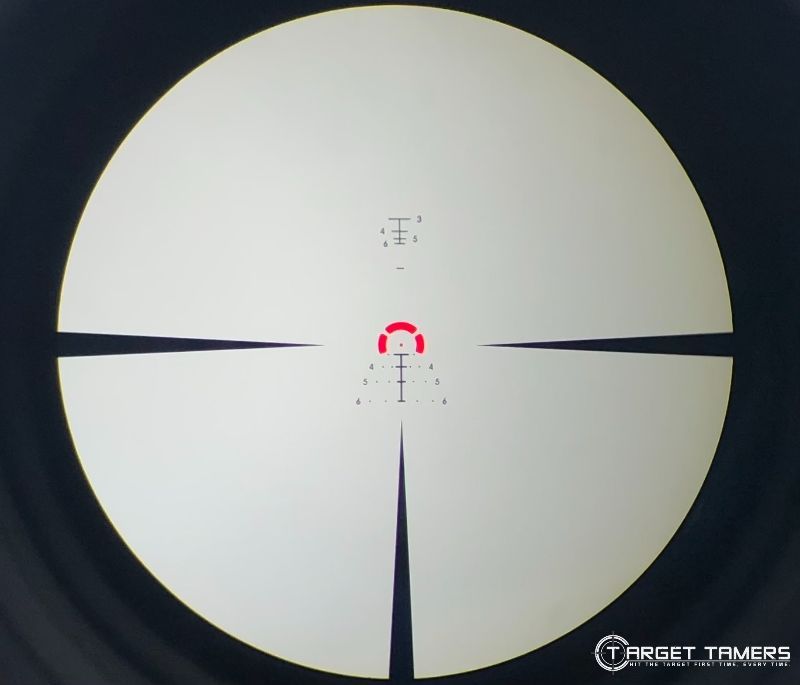
It’s also important to consider reticle illumination. Not all LPVO scopes offer full reticle illumination as some may only illuminate the center dot. Personal preference and application will determine what you like and what is needed.
Another point is that LPVO reticles are typically laser-etched onto the glass. This makes for a reticle that is unbreakable and visible regardless of battery power. You can also switch off illumination for a black reticle when the situation necessitates.
As a side note, glass-etched reticles tend to be easier to see for those with refractive error conditions.
Winner: LPVO
7. Eye Relief
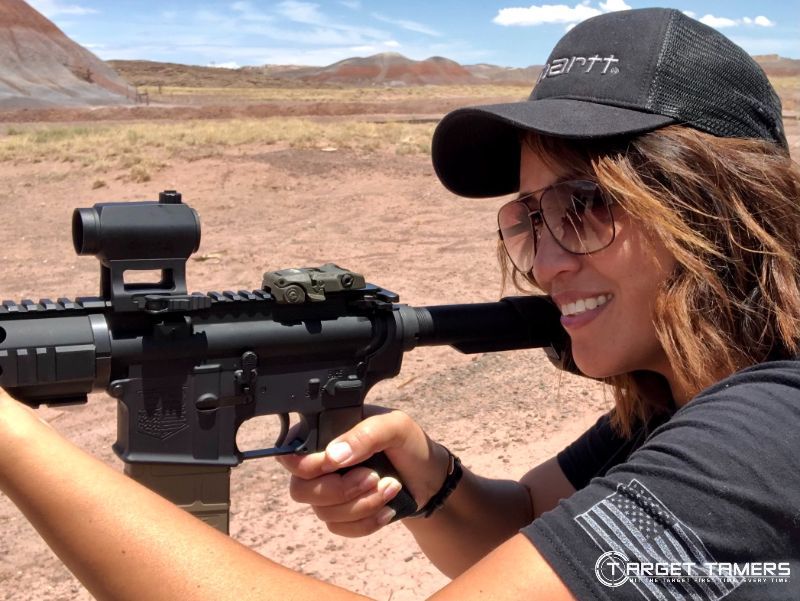
Overall, red dot sights have unlimited eye relief making them excellent optics to top all sorts of firearms. They can be mounted far forward on a scout rifle, seen at arm’s length on a handgun, and placed in the most convenient position atop an AR-15.
An LPVO is still a rifle scope and therefore requires mounting where the full FOV is accessible with your cheek weld and to avoid scope bite (scope to eye – serious ouch!). Like conventional riflescopes, the eye relief for a LPVO typically ranges between 4-2”.
| LPVO Product | Eye Relief (Inches) | Magnification |
|---|---|---|
| EOTech Vudu 1-6x FFP | 3.94 – 3.32” | 1-6x |
| Vortex Strike Eagle 1-6x SFP | 3.5” | 1-6x |
| Steiner T5Xi 1-5x SFP | 4.3 – 3.5” | 1-5x |
It’s clear the red dot sight is unbeatable when it comes to eye relief even against conventional long eye relief scopes.
Winner: Red Dot
8. Field of View (FOV)
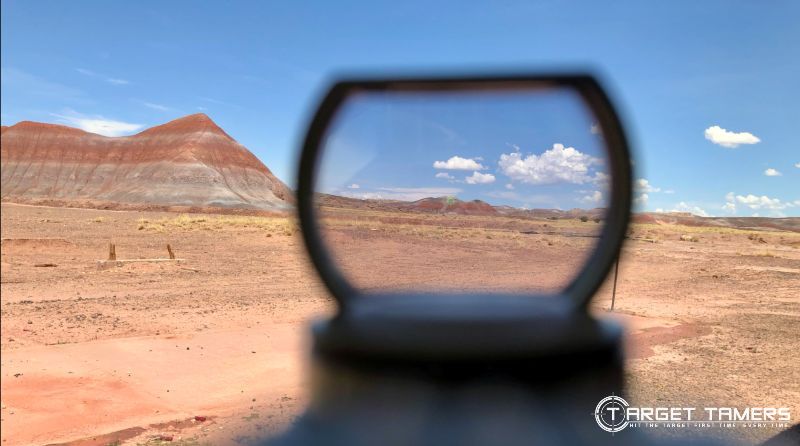
FOV is a non-issue with red dot sights as they facilitate two-eyes-open shooting with no magnification. This allows for peripheral vision preservation and there is quite the case for the benefits of shooting with two eyes open. Nevertheless, we can see through the sight as we see with our own eyes.
Generally, the larger the red dot sight window, the easier it is to find the dot and shoot from off-angle positions. But the window is really just a place to allow us to see the dot as it doesn’t restrict our vision to the parameters of the red dot sight window.
Paying attention to FOV with magnified scopes, like the LPVO, is important. Beyond 1x, the FOV becomes narrow restricting how much can be seen through the sight picture. This is desirable when increasing magnification as it allows for better seeing at longer ranges.
FOV varies between scopes. Some examples are shown below.
| LPVO Product | FOV @ 100 Yards | Magnification |
|---|---|---|
| EOTech Vudu 1-6x FFP | 102.4 – 16.7 ft | 1-6x |
| Vortex Strike Eagle 1-6x SFP | 116.5 – 19.2 ft | 1-6x |
| Steiner T5Xi 1-5x SFP | 108 – 21 ft | 1-5x |
Winner: Red Dot
9. Low Light
There are a lot of factors that will come into play when it comes to how either a red dot sight or LPVO would perform in low light conditions. The first and foremost obvious factor would be the objective lens size. Most closed red dot sights have a 20mm lens while many LPVO sights have a 24mm lens.
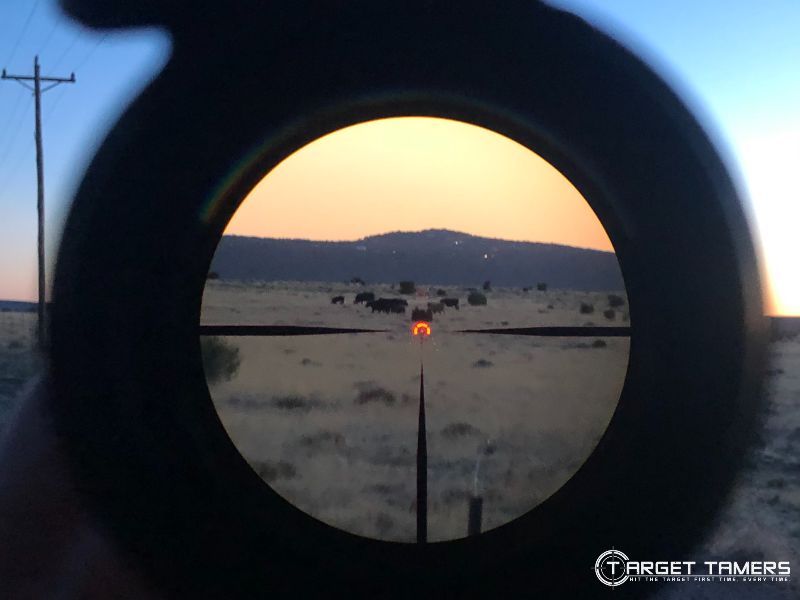
Though the LPVO has the ability to let in more light, it has to a lot of glass to hit before it reaches the eye reducing how much light actually reaches it. In contrast, the red dot has minimal lenses in its optical path.
However, scopes have higher grade coatings and high-quality objective lens glass materials to make this loss negligible compared to a red dot in dim light. In fact, the optical design and materials and coatings used is the significant difference between the two optics in how it performs at night.
Another consideration is exit pupil and how that plays a role in low light visibility. At 1x on either optics, you can have a 20-27mm exit pupil, but the human eye can only dilate so much to use all that light.
What is a better comparison is how much magnification can be used in a LPVO before the exit pupil size matches and then narrows to smaller diameters than the dilated human pupil.
Example: 1-5x LPVO vs 1x red dot sight
- 1x20 red dot = 20mm exit pupil
More light than needed for a fully dilated, healthy pupil of 7mm in dark conditions.
- 1-5x24 LPVO = 24-4.8mm exit pupil
At 3x, the exit pupil is 8mm. It’s more light than needed, but it means that you can adequately use 3x magnification on a LPVO with the same amount of resolution as is seen at 1x and 2x.
Lastly, most of the issues with red dot sights used in low light is the illumination intensity. They must be turned down to the dim settings to allow the sight to be usable. Some red dot sights are too bright even in the lowest settings and they wash out the target and FOV while the dot itself seems to starburst.
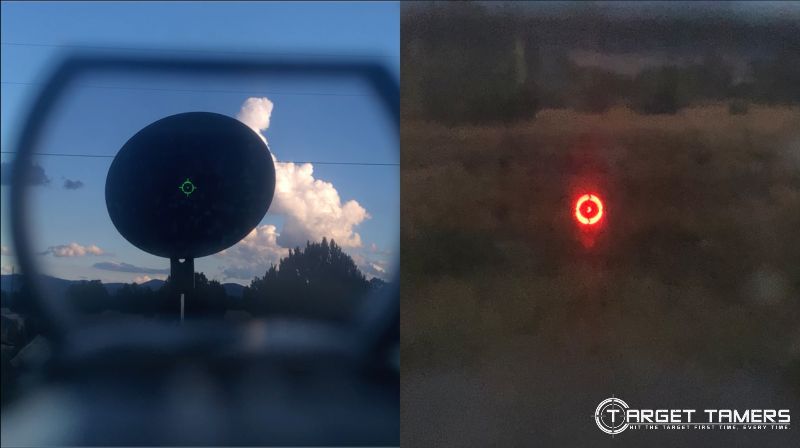
However, some red dot sights have extremely dim settings and are compatible with night vision devices. These may be a good option to try for dawn, dusk, and nighttime hunting.
Winner: LPVO
10. Night Vision
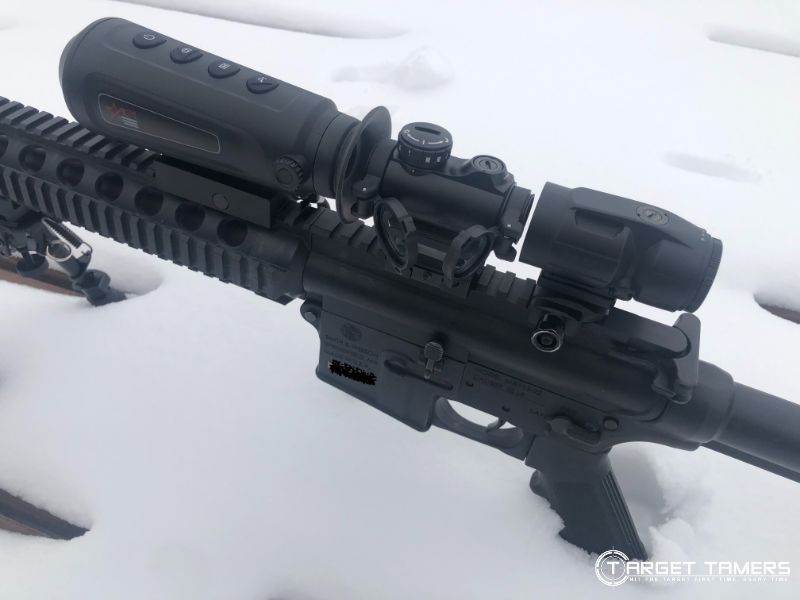
Using night vision with an LPVO is not unheard of. Whether it’s by looking through the eyepiece with NV goggles on or a PVS-14 mounted on the rail. Unfortunately, it’s not as easy as it sounds as eye relief, mounting positions, and getting decent alignment can be a struggle.
One of the most common optics to use with night vision is a red dot sight. They take up little room on the rail and can be mounted as far forward or rearward to necessitate use with mounted NV monoculars or head-mounted NV goggles.
Not any red dot will do. It’s recommended to only use night vision compatible red dots that have dim intensity settings that it won’t do permanent damage to your NVD. The dot is not visible to the naked eye but can be detected with night vision gear.
| Red Dot Sight | Night Vision Compatible | Price Range |
|---|---|---|
| Sig Sauer Romeo MSR | 2 NV settings | Under $100 |
| STNGR Axiom II | 2 NV settings | Under $150 |
| Holosun HS510C | 2 NV settings | Under $350 |
| Aimpoint Pro | 4 NV settings | Under $500 |
Winner: Red Dot
11. Hunting
Aiming points provide better sights on your target and potentially improve accuracy. Both red dot sights and scopes fulfill these purposes. Both can be used in low light to some extent, but factors such as distance, target size, and visual acuity will narrow down which serves better in the hunt.
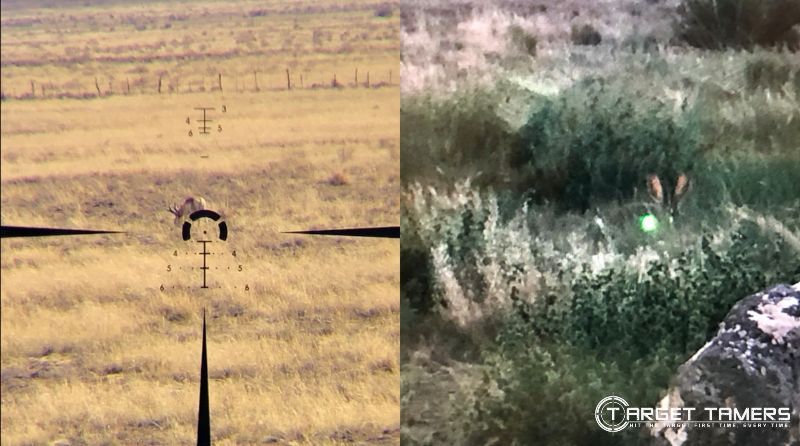
In a red dot sight, dot subtension can become too large at greater distances covering much of the kill zone to be accurate. This makes it difficult for long range use where the LPVO would reign superior; besides, acknowledging the fact that it can be very hard to see without magnification must be considered too.
However, for short ranges even up to 300 yards, a red dot can be effective for the hunt in the practiced hand. Mostly used for dangerous game hunting, coyote and hog hunting, and small game and varmints like rabbits and squirrels, the red dot can be a fast target acquisition optic for hunters.
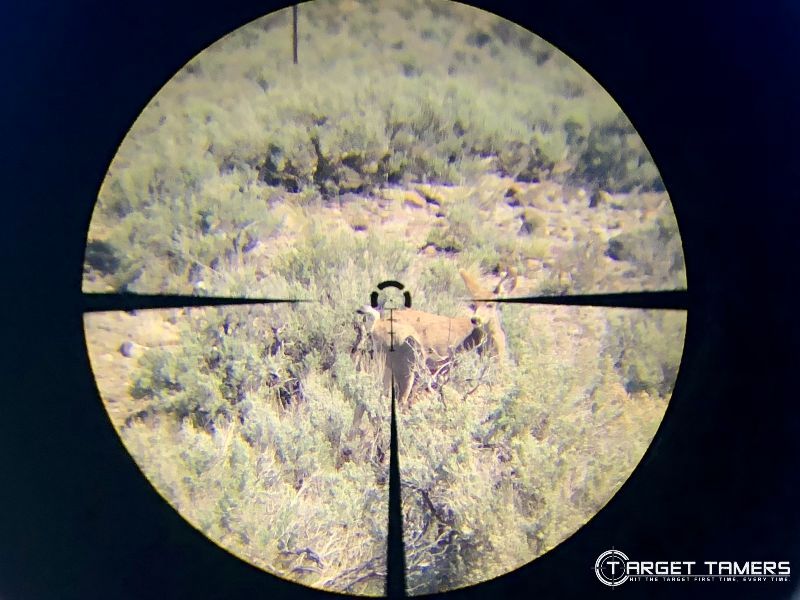
The LPVO offers quite a few more advantages for hunters. It has variable magnification for longer reach and seeing, various holdover reticles to go the distance, and usually a smaller center dot to make sure subtension does not cover up too much on long-range, small targets.
Although, the weight of a LPVO is a legitimate concern to a hunting rifle setup.
Winner: Tie
12. Target Shooting
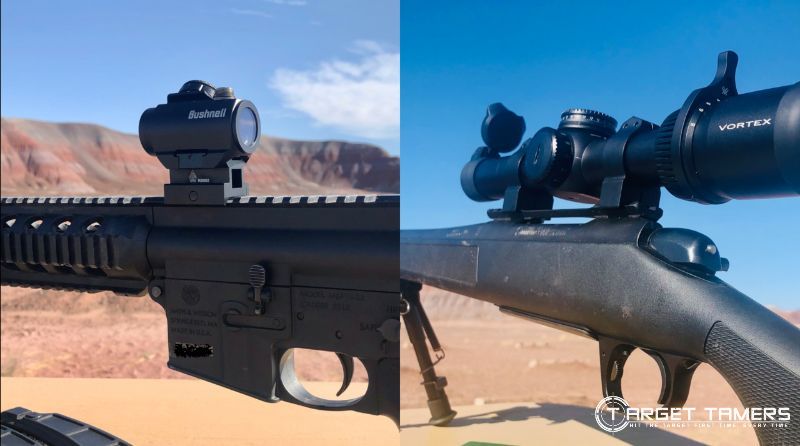
Recreational target shooting includes hitting steel, sighting-in scopes and sights, chasing groups, and plinking. It may depend on the purpose and type of firearm that is being used that will determine whether the LPVO or red dot sight will make for a productive trip to the range.
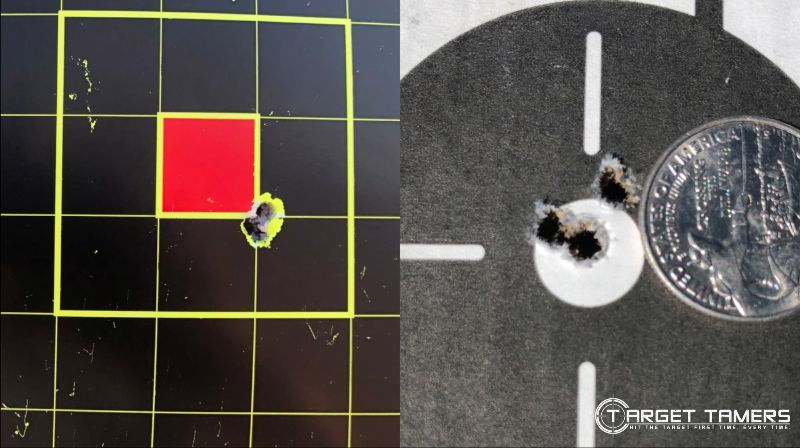
If you’re chasing groups beyond 100 yards with a rifle, the LPVO is best suited to the task. Popping off rounds to hit steel for training or pleasure is a field both the LPVO and red dot will perform well in. However, the red dot is best for a handgun and speed.
Winner: Tie
13. 3-Gun
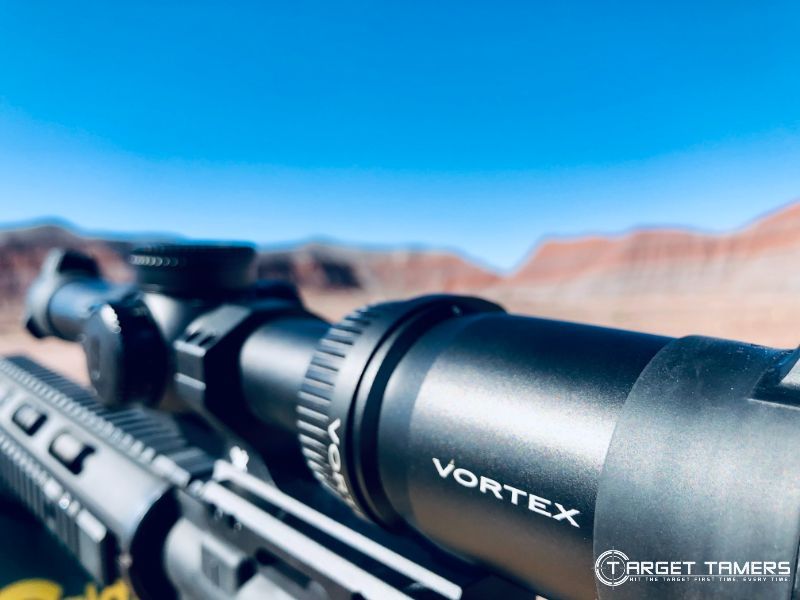
The 1-6x LPVO has been a winning configuration for 3-gun competitors given its balance between red dot-like performance with the benefit of magnification for distance. It remains a popular option versus alternative configurations due to cost, weight, and usually better eye relief at maximum power.
A throw lever allows for rapid power changes in a match that takes you from point-blank range to 300 yards or more. However, even using a throw lever can take mere microseconds longer than rotating the stock in your shoulder to use an offset red dot sight. Enter here, the LPVO + offset red dot.
Another popular 3-gun combo is the red dot sight + magnifier versus the LPVO. Put a 3x mag behind the RDS and you have a great setup. But there can be issues related more to the magnifier than the red dot itself.
At the end of the day, 3-gunners are leaning towards the LPVO for ease of use and its quality performance output – with or without an offset red dot.
Winner: LPVO
14. Home Defense, SHTF, Law Enforcement
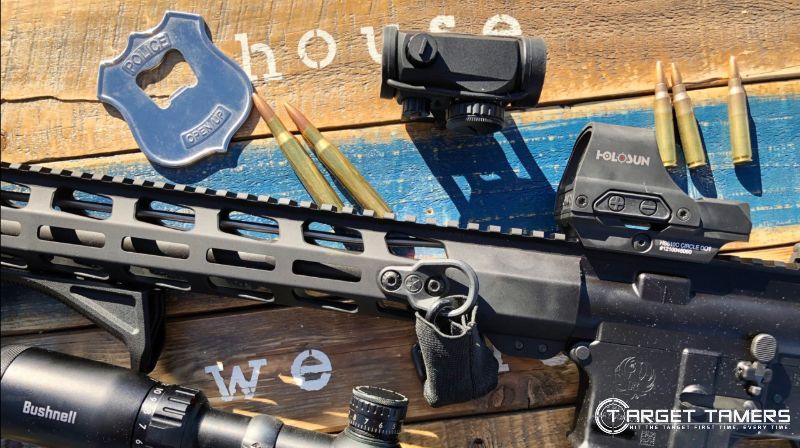
On average, determining what the optic will be used for 80-90% of the time may also serve the secondary application well. A red dot for SHTF may serve for home defense. However, to cater to the dynamic needs of law enforcement, more versatility may be required than what a red dot can provide alone.
Everyone’s standard for what they want from a home defense and SHTF optic varies. Some justify a budget red dot sight suitable enough for home defense as a backup or failsafe. Be that as it may, others will invest more in the optic that’s reserved for life-saving engagements.
With that in mind, red dot sights reserved for these purposes usually feature motion sensor technology or continuous-on performance with long-lasting battery life. This ensures that your optic (and firearm) is instantly ready should the need arise to use it.
Since red dots are excellent for close-quarter engagements and on law enforcement handguns, certain situations will require a sight for distance in which a red dot cannot compete with the LPVO.
The LPVO comes to mind as a suitable optic for law enforcement AR platforms like the AR-15 5.56 and 300 BLK. Officers, deputies, and troopers can quickly crank up power to determine if a long-range target is an immediate threat and can incorporate use of a BDC reticle to engage.
Winner: Tie
15. AR-15 & Pistol
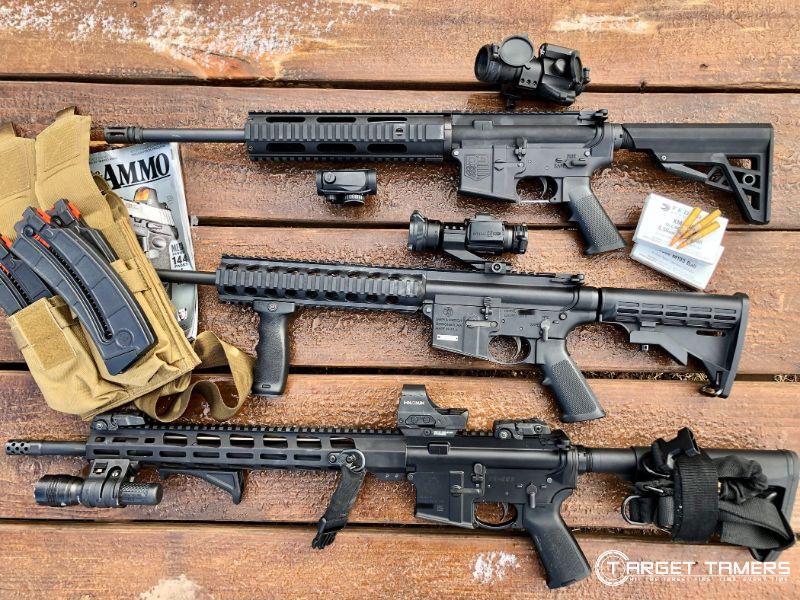
In general, LPVO scopes are too long and heavy to be mounted to a handgun, although they may be able to mount appropriately to AR-platform pistols. Deciding between a red dot sight or LPVO for the pistol or AR-15 will come down to personal preference and application.
Red dot sights are the optic of choice for close-range distances, fast target acquisition, cost, weight, and rail mounting length. Micro red dot sights are also the appropriate option for handguns and many IWB and OWB holsters can be cut to accommodate for it.
LPVO scopes are valuable for variable magnification, close to long-range distances, better optical quality (potentially), and to serve as a jack-of-all-trades optic. Due to its longer length and therefore mounting length, it’s more appropriate on top a rail that has the space to accommodate it, i.e., an AR-15.
Winner: Tie
16. Cost
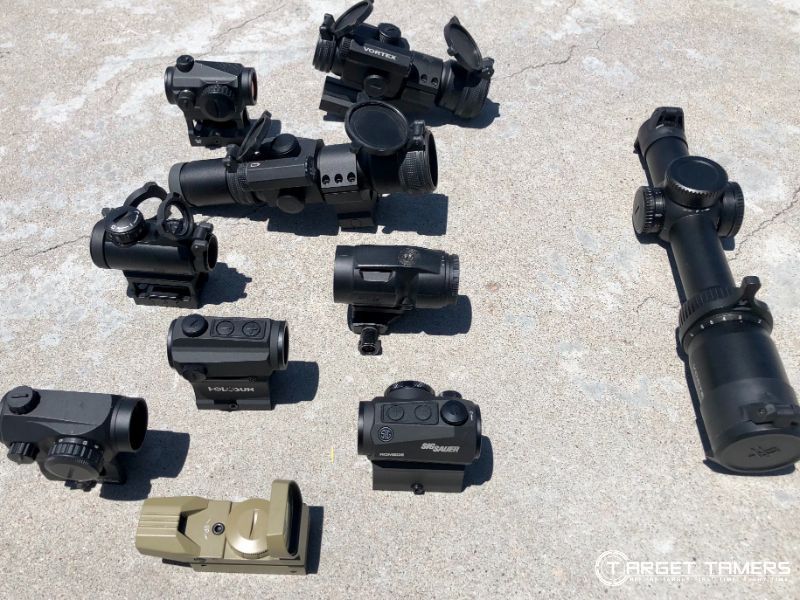
Overall, red dot sights are more affordable than LPVO riflescopes. They can be as economical as $50 but can also cost close to over $500. More expensive red dot sight brands include Trijicon, Aimpoint, and EOTech. LPVO scopes are more expensive but there are budget options for around $100 to $300.
What makes for the significant price difference between red dot sights? The technology and quality. Reflex sights are much simpler to make and are therefore cheaper. Red dots in the holographic category are difficult to make and are therefore more expensive.
LPVOs are much like conventional riflescopes in that they can be as affordable as $150 but can also cost upwards of $2000.
| LPVO | RED DOT | ||
|---|---|---|---|
| Product | Price Range | Product | Price Range |
| Nightforce NX8 1-8x | Under $2000 | EOTech XPS3 | Under $800 |
| Vortex Strike Eagle 1-8x FFP | Under $1000 | Aimpoint Pro Patrol | Under $500 |
| Burris RT-6 1-6x | Under $500 | Vortex Venom 6 MOA | Under $250 |
| Firefield Rapidstrike 1-6x | Under $150 | Sig Sauer Romeo MSR | Under $100 |
Winner: Red Dot
17. Battery Life
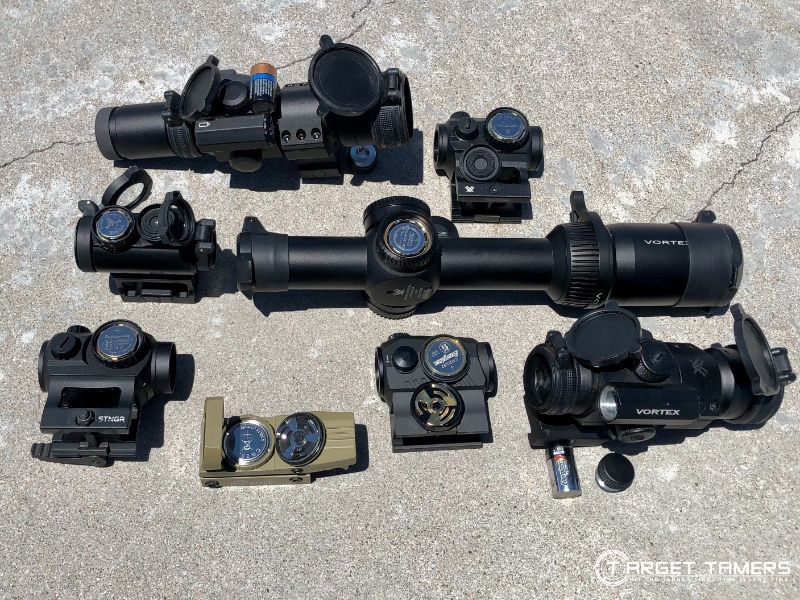
There is no comparison when it comes to the battery life between LPVO scopes and red dot sights. Most optics these days take the same type of battery to power illumination in both types of optics, the CR2032, although CR1632 and CR2 batteries are often seen.
Red dots vary in battery lifetime from 600 hours to over 50,000 hours. There can be a significant difference in runtime between green and red illumination with the advantage to red. Additionally, most battery runtimes stated by the manufacturer are for mid-intensity settings. Battery life will deplete faster with max illumination.
| LPVO | RED DOT | ||
|---|---|---|---|
| Product | Battery Life (Approx.) | Product | Battery Life (Approx.) |
| Trijicon Credo 1-6x | 68 hours | Holosun HS510C | 50,000 hours |
| EOTech Vudu 1-6x | 500 hours | STNGR Axiom II | 50,000 hours |
| Swampfox Arrowhead 1-10x | 380 hours | Trijicon MRO | 5 years |
On the contrary of needing illumination, LPVO scopes do not require it to remain functional. The Bushnell AR Optics 1-4x24 LPVO does not have illumination at all. With a wire or glass-etched reticle, it’s still visible and usable without illumination.
If the batteries fail, you can keep on shooting with a LPVO. With a red dot sight, you’re done. However, most people are consigned to requiring batteries for operation and it’s the illumination that attracts them to red dot sights and LPVOs. So, in terms of runtime, red dots have it.
Winner: Red Dot
18. LPVO VS Red Dot + Magnifier
The obvious comparison to point out between LPVOs and red dots with magnifiers is the magnification. A LPVO still reigns superior as it has variable power – you can adjust the power range between what is available. With a red dot and magnifier combo, you’re limited to the fixed power of the magnifier.
This may not be a significant compromise to live with, but it is worth it to also consider other relevant features between a mag and a LPVO. First and foremost, eye relief.
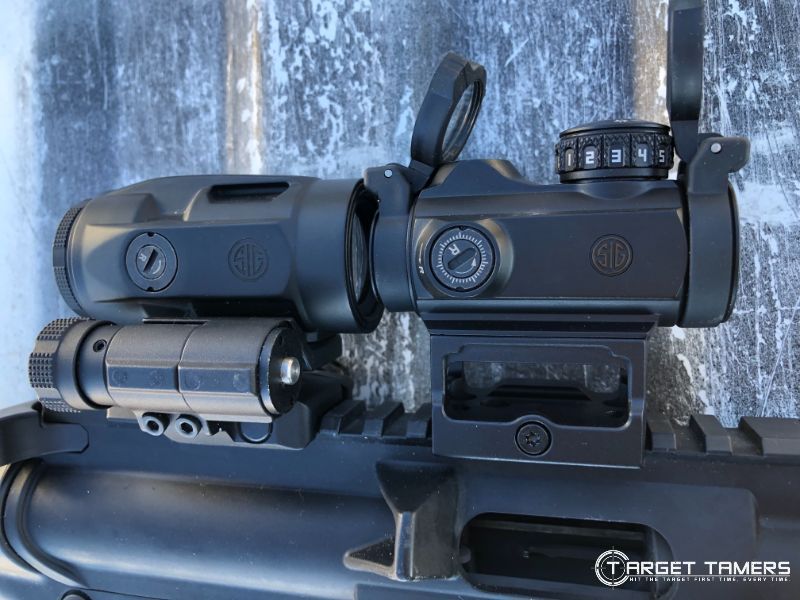
Magnifiers have a pretty bad rap of having very tight eye relief. Most mags will have eye relief between 2-3”.
LPVO scopes have better eye relief at 1x, but just like conventional riflescopes, it shortens as magnification is increased. Even so, the minimum amount of eye relief is still generally more forgiving than the eye relief of a magnifier.
Secondly, dot size. It’s a trap to believe the myth that magnifiers increase dot size. Technically, this can be considered true, but the magnifier is also increasing the image.
For example, with a 2 MOA dot in front of a 3x magnifier, the dot appears larger but is still 2 MOA in relation to the target (subtension) because the image has also been magnified 3x. This is comparable to a FFP LPVO. The reticle technically becomes larger but subtension remains the same as magnification is increased.
The real considerations to muse over would be fixed vs variable magnification and eye relief.
| LPVO | MAGNIFIER | ||
|---|---|---|---|
| Product | Eye Relief (Inches) | Product | Eye Relief (Inches) |
| EOTech Vudu 1-6x FFP | 3.94 – 3.32” | Sig Sauer Juliet 4 (4x) | 2.55” |
| Vortex Strike Eagle 1-6x SFP | 3.5” | Bushnell Transition 3x | 3.34” |
| Steiner T5Xi 1-5x SFP | 4.3 – 3.5” | EOTech G33 (3x) | 2.2” |
Winner: LPVO
LPVO VS Red Dot Pros & Cons
LPVO Pros & Cons
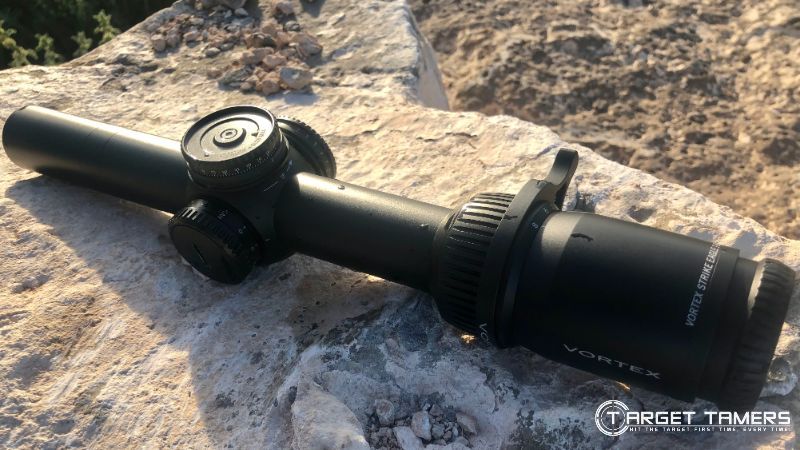
Pros:
- Magnification
- Close to mid-range use
- Various reticle options
- Glass-etched reticle that is visible with no battery
- Can be a better option for refractive error conditions
Cons:
- More expensive than red dot sights
- Larger and heavier than red dot sights
Red Dot Pros & Cons
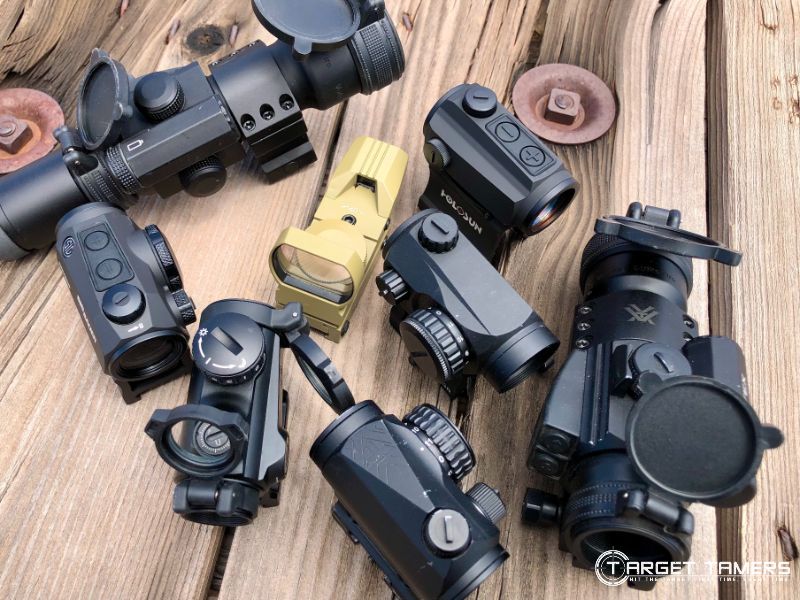
Pros:
- Cheaper than LPVO
- Unlimited eye relief
- Simple, easy to use dot
- Lightweight/compact
- Mounts well to rifles and pistols
Cons:
- No magnification
- Best suited for close-range use
- No aiming dot without battery
Should I Use a Red Dot or LPVO?
Overall, there are applications that will determine if variable magnification is needed, if a long-range distance can’t be closed, or if a light weight and compact size is essential. Evaluating the factors plus personal preference will narrow the gap between a LPVO and red dot sight.
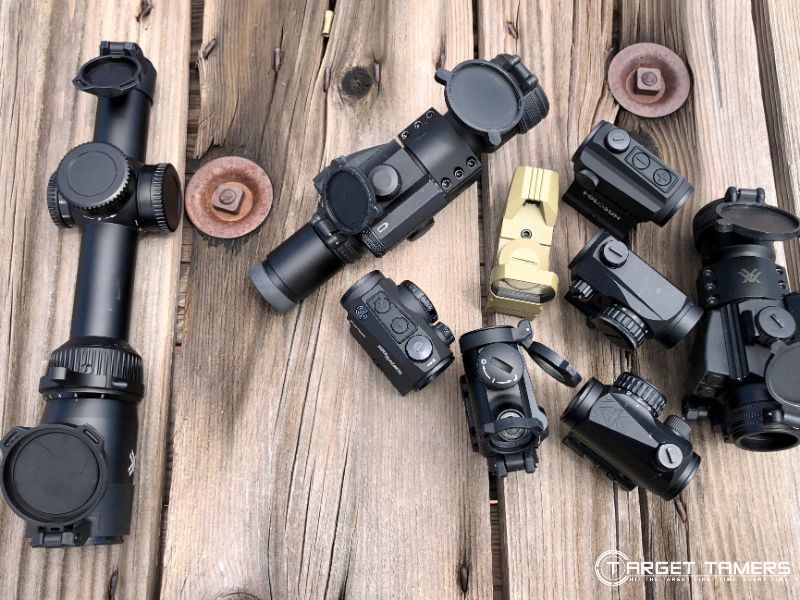
They’re different enough in design and performance that you can own both. But if it comes down to making a hard decision by choosing only one, you should be able to figure out by now which is better for your intended purposes.
Both types of optics are kings in their own right, and they each have strengths that lend them towards superiority in various applications.
What are you shooting for?
Further Reading



